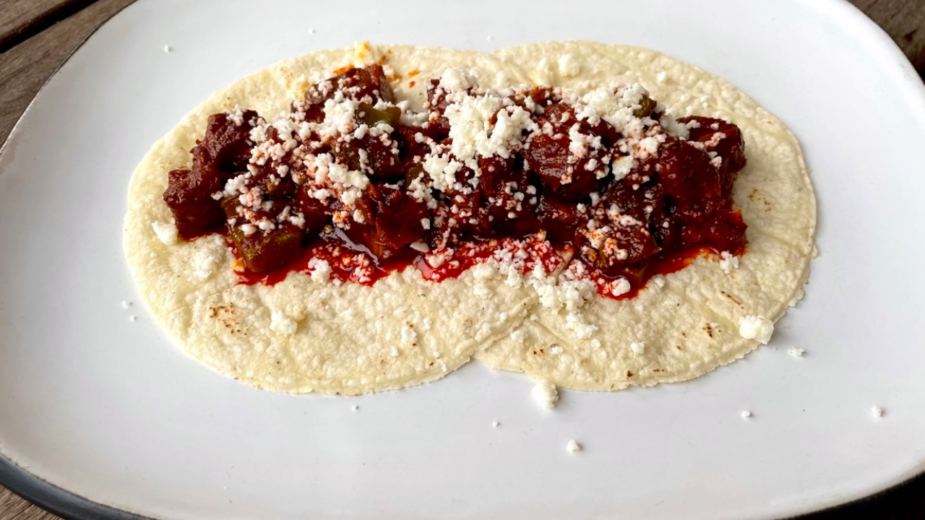
If the nopales you buy aren’t cleaned (at some Mexican groceries, you’ll find them cleaned and cut into small pieces), clean them one by one: Holding a paddle with a pair of tongs, trim off the edge that outlines the paddle, including the blunt end where the paddle was severed from the plant, then slice or scrape off all the spiny nodes from both sides. Cut the paddles into ½-inch squares or into ¼-inch strips (if any are longer than about 2 ½ inches, cut them in half).
INGREDIENTS
- 2 pounds pork shoulder roast, cut into pieces a little smaller than 1 inch
- Salt
- 3 tablespoons fresh-rendered pork lard , bacon drippings or vegetable oil, plus a little more if needed, divided use
- 2 1/2 ounces (about 10 medium) dried guajillo chiles, , stemmed, seeded and torn into flat pieces
- 4 to 6 árbol chiles , stemmed
- 6 garlic cloves, peeled
- 1/2 teaspoon ground cumin
- 1 teaspoon dried Mexican oregano
- 1 teaspoon fresh black pepper
- A little sugar, if needed
- 1 pound (about 5 medium) nopal cactus paddles, cleaned and cut into small pieces or strips (4 cups if you buy them cleaned and cut into small pieces)
- 24 warm corn tortillas
- Crumbled Mexican queso fresco, for garnish
INSTRUCTIONS
Brown the meat. Sprinkle the meat generously with salt. In a large (4-quart) saucepan or small Dutch oven, heat 2 tablespoons of the lard, drippings or oil over medium-high. When hot, begin browning the meat in batches, one uncrowded layer at a time, stirring regularly until richly golden, about 4 minutes per batch. When ready, remove each batch to a bowl or large plate, draining as much fat as possible back into the pan. If necessary, add more fat before continuing to the next batch.
Make the sauce. Return the pan to medium heat. When hot, fry the chile pieces a small handful at a time, turning them nearly constantly with tongs or a slotted spoon as they toast and release their aroma. (It’ll only take a few seconds. They’ll lighten in color a little on the flesh side. Too much toasting will give the sauce a bitter edge.) Immediately remove to a bowl, leaving behind as much fat as possible. Lightly toast the arbol chiles in the same way, scooping them in with the guajillos. When all chiles are toasted, cover them with hot tap water, weigh with a plate to keep them submerged and rehydrate for about 30 minutes.
Meanwhile, with the pan back on medium heat, remove any chile seeds you see. Add the garlic and cook, stirring regularly, until soft and lightly browned, about 3 minutes. Remove it to a blender jar, again leaving behind as much fat as possible. When the chiles are rehydrated, use tongs or a slotted spoon to remove them to the blender jar, and add 1 cup of their soaking liquid, as well as the cumin, oregano and black pepper. Blend until smooth. Return the saucepan to medium-high heat and check that the bottom is coated with lard or oil, adding more fat if necessary. When hot, set a medium-mesh strainer over the pot and press the chile puree through. Cook, stirring the strained chile puree for several minutes, until it darkens in color and reduces to a thick mixture the consistency of tomato paste. Add the meat to the pan then stir in 2 cups water, and bring to a simmer. Reduce the heat to medium-low and simmer, partially covered, until the meat is tender, about 45 minutes. If the sauce has thickened beyond the consistency of cold heavy cream, stir in a little water. Taste and season with salt, usually about 1 ½ teaspoons. If the sauce has more than a hint of bitterness, stir in a teaspoon or so of sugar to balance it.
Cook the nopales. While the meat is simmering, scoop the cactus into a medium (2- to 3-quart) saucepan and add 1 tablespoon of the oil and ½ teaspoon salt. Cover, set over medium heat and cook, stirring once or twice for about 5 minutes. Uncover the pan and continue to cook, stirring regularly until all of the liquid has evaporated and the mixture is just beginning to sizzle in the oil, 5 to 10 minutes more. When the meat is tender, stir the nopales into the pot. You’re ready to serve with warm corn tortillas and crumbled fresh cheese for making tacos.




